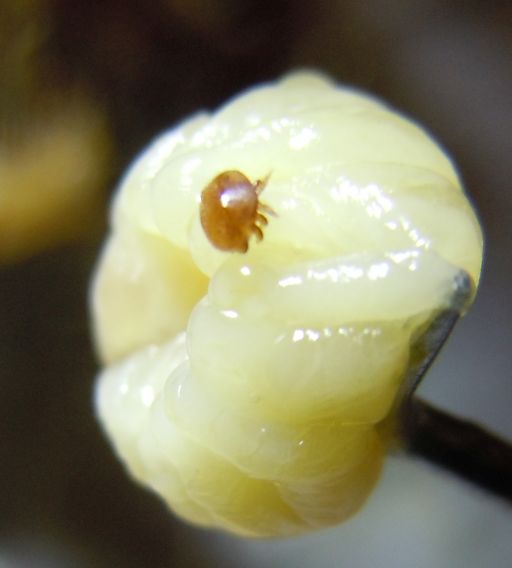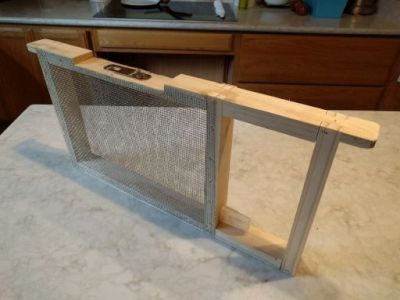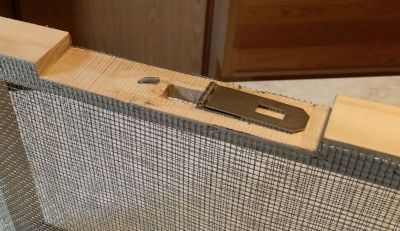Last month, we attended the South Carolina State Beekeepers Association summer conference in Florence, SC. I would say that over half of the conference was devoted to discussing strategies for combating this little beastie – the Varroa Destructor mite.

This parasite is intimately connected with the honeybee, laying its eggs in the honeybees’ brood cells, and feeding off the honeybee larvae. It is particularly fond of drone larvae (shown in this photo) because drone larvae remain in their capped cells longer than worker and queen larvae. Once the honeybee larvae emerge (assuming they survive the mite infestation in their cells), the adult mites then attach themselves to adult honeybees, feeding off them until the mites can mate, and begin the cycle again. Left unchecked, the mites can destroy honeybee colonies either directly, by feeding on the honeybee larvae and adults, or – more commonly – as a vector for spreading diseases which the mites carry, and which may be fatal to the honeybees – e.g. Deformed Wing Virus. Viruses which were unable to penetrate perimeter defenses of the honeybees’ formidable immune system are able to get directly into the honeybees’ blood and digestive tract by being injected by the mites as they feed on their honeybee hosts’ bodily fluids.
Most beekeepers have turned to chemical treatments to combat the mites. Unfortunately, over the course of the thirty some odd years since the mites first appeared in North American colonies, the mites have become resistant to many of these treatments. Furthermore, the most effective of the chemical treatments are harmful to honey, and it is not advisable to harvest honey from hives which were treated with such chemicals, or legal to sell or even give away such honey.
Among those researching the Varroa mite problem is Randy Oliver, who has published a great deal of useful information about his experiments in American Bee Journal, and on his own website – Scientific Beekeeping. At the recent conference, the buzz (nyuk, nyuk, nyuk) was all about Randy’s latest experiments with a new slow-release method of dispersing one of the most effective chemical miticides – oxalic acid – into the hive by dissolving the acid in food-grade glycerine, and then placing disposable blue shop towels soaked with this solution into the hive.The idea is that the bees will attempt to remove the foreign material from the hive by nibbling away the shop towel and carrying it to the hive entrance. In doing so, they will get the oxalic-acid-impregnated glycerine on their bodies, and will then carry it throughout the hive, effectively dispersing the acid among neighboring bees, and on any adult mites that may be present. The reason the new method is so promising is that the acid will remain present in the hive throughout an entire honeybee brood cycle. Thus the acid will kill not only adult mites riding on adult bees, but also mites that were inside the honeybee brood cells at the time the towels were placed into the hive, once the bees emerge or their carcasses are removed from the cells where the mites killed them. Previous oxalic acid application methods had to be repeated weekly for three weeks in order to kill mites at all stages of their development. Furthermore one of the common methods of applying oxalic acid by vaporizing the acid powder requires a considerable investment in equipment, both to heat the acid and disperse the vapors, and protective equipment for the beekeeper applying the treatment. A summary of Randy Oliver’s experiments with the shop towel application method may be found here. Unfortunately, Randy’s experiments show that the shop towel application method will not work very well with our horizontal hives. This is because Randy found that the bees need access to both sides of the shop towel in order to effectively nibble it up and spread the oxalic acid around the brood nest. This works fine on ordinary Langstroth hives which usually have a two-level brood nest, where the shop towel may be placed on top of the lower brood box frames, below the top brood box.
Another common theme at the conference was the idea of the so-called “varroa bomb.” Foraging worker honeybees can travel for several miles around their home hive, sometimes carrying Varroa mites with them. Occasionally, a worker honeybee will “drift” into another hive, and not return to its home hive after foraging. If such a bee’s keeper does not manage the Varroa population in her local hives, drifting bees can carry mites to neighboring colonies. Furthermore, hives with honeybee populations decimated by Varroa mites are subject to robbing of their honey and pollen stores by other colonies. Robbing bees may come into contact with the mites, and bring them and the diseases they carry back to their own home hives. Thus a beekeeper who does not properly manage the mites can impact the health of neighbors’ honeybee colonies.
The Varroa mite population in most honeybee colonies increases strongly in late summer. This can be catastrophic to the colony which must be strongly gathering stores for the upcoming winter. Now that August is upon us, it is time to decide how we want to control Varroa population in our hives. When we first decided we wanted to keep bees, we had hoped to be able to keep them without chemical treatments. This is still our desire, but we have one hive (the one we had a laying worker issue with earlier in the year) that we know is infested with Varroa, and that means the other two hives are likely infested as well. One strategy known to help is breaking the honeybee brood cycle (along with the associated Varroa mite brood cycle). I found an excellent article about this strategy at the Massachusetts State Beekeepers Association site. Essentially, the idea is to force the colony to be broodless for long enough to clean all the mites out of the brood cells, and to treat the hive for adult mites once a week during the brood break. The Massachusetts strategy involves either killing or removing the queen from the colony, and allowing the colony to raise a new queen which will then need to mate before it is able to begin laying.

Our planned approach will be slightly different. We intend to keep our queens in their colonies, but unable to lay. To accomplish this, I built three queen isolation frames based on pictures I found on the web after getting the idea from a friend in my local beekeepers club. Rather than removing the queens, we hope to capture them, and put them into these isolation frames. That way, their scent will still be present in the hives, and hopefully, this will deter the workers’ urge to raise up replacement queens in their places. We will also be able to use these frames in the future whenever we introduce new queens into our hives.
The isolation/introduction frames have a hole in the middle vertical member where a standard queen cage may be plugged when introducing a new queen to the colony. There is also an opening in the top bar into which a queen may be dropped. This opening has a metal hasp to cover it which can be flipped open to allow the queen inside to exit.

I built these frames with the dimensions of an ordinary deep frame with the idea that it would discourage the bees from building comb underneath it. Duh! I didn’t even think about the possibility that they might draw comb down from the top bar in the open part of the frame where the queen cage has been inserted. Also, I made it wider than a normal frame, with the idea of discouraging the bees from drawing out honey store comb on the adjacent frames.
While our queens are imprisoned in these isolation frames, we will “treat” for the adult mites each week by heavily smoking the hives using Staghorn Sumac berries in our smoker. I have heard various things from various beekeepers about the efficacy of this method. The most sensible thing I saw was that it’s not what’s used in the smoker, but rather the smoke itself that helps with the mites. All smoke leaves a residue, and the bees will want to clean that off of each other once they’ve been exposed to it. Hopefully, in the process, they’ll also be cleaning mites off of each other, and these will then drop through the screen bottoms and into the oil traps below, where they will hopefully die. That’s the theory, anyway. We’ll see how it goes.

Here’s a quick update:
We finally had a decent day to do our hive inspections (first time in 2 weeks). We tried our best to find our queens, but couldn’t, so we didn’t get to trap them to do the brood cycle break we had intended. We did remove all the drone brood we could find in the hive with the heaviest mite infestation. We ought to be able to do this by now, but we’re going to need help finding and trapping those queens.
The good news is that our girls are putting up stores like crazy, even in the midst of the summer dearth. We added some empty frames to all three hives. That’s one of the big advantages of the horizontal hives – we can fill them up with frames one at a time as our girls draw out each new frame and start to fill it with stores. That way we don’t have a bunch of half-drawn frames.
Very nice write up. I am looking forward to the results.
Thanks, Larry.
As I told another beekeeper friend, regurgitation helps me to retain (although that sentence, on its face, makes no sense at all). I really just wanted to show off my mite picture. Not bad for a five-year-old point-and-click camera, huh? I wish the weather would cooperate a little. We had planned to go in this week in search of our queens, but it won’t stop raining. I spent way too many years in the Arabian desert to ever complain about the rain again, though.